
Tamron SP 70-200mm VC G2 lens for Nikon
About Tamron
Tamron is a Japanese company that specializes in the design and manufacture of photographic lenses, optical components, and various other optical products. Founded in 1950, Tamron has a long history of producing high-quality lenses for various cameras, including DSLRs, mirrorless cameras, and other imaging devices. The company is known for its innovative lens designs and commitment to providing affordable yet excellent optical products.
C€
- The C€ Marking is a directive conformity mark of the European Community (EC).
EEC
- The EEC Conformity Report applies to the Council Directive 2014/30/EU, 2011/65/EU and is used by Tamron Co., Ltd., manufacturer of this product.
Thank you for purchasing this Tamron lens. Before using your new lens, please read the contents of this Owner’s manual to properly use the lens. Also, it will be important to read the manual of the camera to which you will attach the lens. After reading, store this Owner’s manual in a safe place. Please read also the document “Precautions for Safe Use of Tamron Lenses” supplied with the lens for the detailed safety precautions to observe when using Tamron lenses.
- Explains precautions that help to prevent problems.
- Explain things you should know in addition to basic operations.
Figures
PART NAMES (Refer to Fig. [1])if not specified)
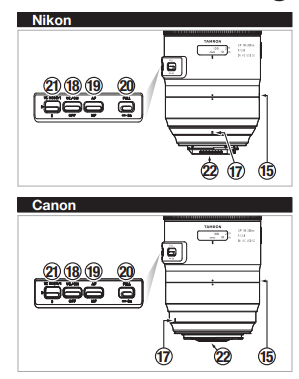
- Lens hood
- Hood attaching alignment mark
- Hood locking mark
- Filter ring
- Hood release mark
- Zooming ring
- Focal length scale
- Focal length mark
- Focus ring
- Distance scale
- Distance mark
- Tripod mount
- Tripod mount mark
- Tripod mount locking screw
- Tripod mount release mark (lens side)
- Tripod mount release mark (tripod side
- Lens attachment mark
- VC (Vibration Compensation) switch
- AF/MF switch
- Focus limiter
- VC mode switch
- Lens-camera interface contacts
- Screw hole for safety lock screw
- Safety lock screw (×2)
- Hexagonal wrench
MAIN SPECIFICATIONS

- Values are specifications of Nikon products.
- Length: Distance from lens front to mount surface. Features and appearances of lenses listed in this owner’s manual are subject to change without notice.
ATTACHING AND REMOVING THE LENS
- Remove the rear cap of the lens. Align the lens attachment mark 17 and mounting mark on the camera, and then insert the lens.
- Rotate the lens clockwise until it clicks and locks. (For Nikon models, rotate counterclockwise.) To remove the lens, turn the lens in the opposite direction while pressing the lens release button on the camera.
Warning:
- Turn off the power of the camera before attaching or removing the lens.
- In the case of Canon cameras. align with the EF lens mark (red circle).
Note: For details, please read the instruction manual of your camera.
SWITCHING FOCUS MODE(Ref. Figs. 1,3 and 4)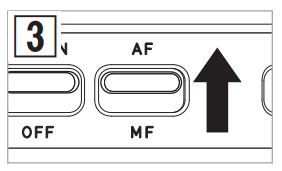

To shoot using autofocus (AF), set the AF/MF switch (19 to “AF” To shoot using manual focus (MF), set the AF/MF switch (9 to “MF”, and then use your hand to turn the focus ring and focus the image.
Warning
- The distance scale 1 is provided as a guideline. It may differ from the actual focus location.
- In AF mode, it may be difficult for autofocus to work depending on the subject.
Notes
- Through the full-time manual mechanism, when focusing on AF, it is possible to switch to MF by turning the focus ring while the AF/MF switch is set to AF. AF can be resumed by releasing your finger from the shutter button and then repressing the shutter button halfway.
- To ensure focus under various conditions, the focus ring 9 rotates past the infinity (∞) position. Accordingly. always check the focus in the viewfinder when shooting with manual focus. even when the focus is aligned with infinity.
- For details. please read the instruction manual for your camera.
VC MECHANISM (Ref. Figs. 1, 5 & 6)
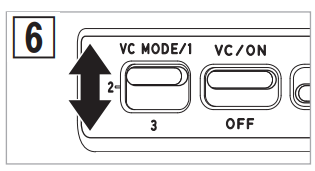
The VC (Vibration Compensation) mechanism reduces image blur caused by hand-held shooting.
How to use VC
When you use VC, set the VC switch @ to ON. Press the shutter button halfway and confirm that the viewfinder image is stable before taking a picture.
Switching VC mode
You can switch the VC mode by using the VC mode switch 2D.
- MODE 1 Basic mode that balances finder-image stability and compensation effects
- MODE 2 Panning mode
- MODE 3 Mode that prioritizes compensation effects, compensating only at the moment the shutter is released.
- MODE 1 and MODE 3 do not support panning.
- For shooting with live view, use MODE 1.
- Settings can be made using TAP-in Utility only for MODE 1.
VC is effective under the following conditions
- Dimly lit locations
- Locations where flash photography is prohibited
- Locations where the footing is unstable
VC may not perform sufficiently under the following conditions
- When a photograph is taken from a vehicle that is shaking greatly
- Shooting during excessive movement of the camera
- When shooting while using a tripod
- Set the VC switch to OFF when taking pictures with bulb photography (long exposures). Otherwise, VC Mav causes a malfunction
Warning
- The viewfinder image may become blurred immediately after the shutter button is pressed halfway. This is due to the principles of VC and not a malfunction.
- When the VC switch is set to ON, the number of recordable images is reduced due to the power used by the camera.
- Set the VC switch to OFF when you are shooting while the camera is secured by something other than your hand (such as a tripod).
Note
- Do not remove the lens from the camera while the VC is on. If the lens is removed while VC is on, the lens may make a clicking sound if the lens is shaken. This is not a malfunction. If the lens is installed on the camera, and the camera’s power is switched on, the sound stops.
- In MODE 2 and MODE 3, the effects of VC at the finder may be reduced, but this is not a malfunction.
- Nikon cameras are equipped with a built-in flash. VC will be turned off while the built-in flash is charging.
USING THE FOCUS LIMITER (Ref. Figs. 1, 7 & 8)

When autofocus is set, switching the focus limiter switch 2 can speed up focusing.
- To limit the autofocus range to distant (infinity to 3 m) subjects (Ref. Fig. 7)
Set the focus limiter switch to “∞o-3 m”. - When not using the focus limiter (Ref. Fig. 8)
Set the focus limiter switch to “FULL”
ZOOMING (Ref. Figs. 1 & 2)
While looking through the camera’s viewfinder, rotate the zooming ring © of the lens to set the focal length suitable for the image, and then shoot.
LENS HOOD (Ref. Figs. 1, 9-11)
A bayonet-type lens hood is provided as standard equipment. We recommend shooting with the hood properly attached because the lens hood eliminates stray light that may affect the picture.
- Using the lens hood (Ref. Figs. 9 and 10)
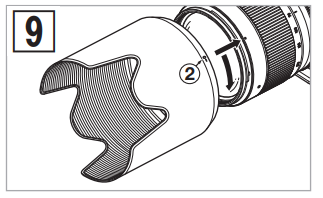
Align the hood attaching alignment mark 2 of the hood with the hood release mark 5 of the lens. Rotate the hood 1 in the direction of the arrow until the hood locking mark 3 meets the hood release mark 5.
- Stowing the lens hood (Ref. Fig. 11)
You can stow the lens hood by attaching it in reverse. Align the hood locking mark of the hood with the hood release mark 5 of the lens. Rotate the hood in the direction of the arrow until the hood attaching alignment mark (2 meets the hood release mark (5)
Warning
- Be aware that the periphery of the photographed image may be darkened if the hood is not attached properly.
TRIPOD MOUNT (Ref. Figs. 1, 12 to 14))
The A025 model comes with a tripod mount. When you use a tripod, lock the lens firmly to the tripod using the tripod mount.
- Changing the directional position of the camera (Ref. Fig. 12)

When you change the directional position of the camera, you can rotate the lens by loosening the tripod mount locking screw M. After determining the shooting position, tightly secure the tripod mount locking screw 14. - Attaching and removing the tripod mount (Ref. Figs. 13 & 14)

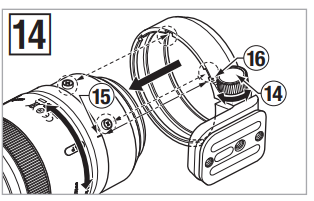
You can mount and dismount the lens by loosening the tripod mount locking screw, rotating the lens, and then aligning the release marks (15 and 16) to the same position. After attachment, tightly secure the tripod mount locking screw 14.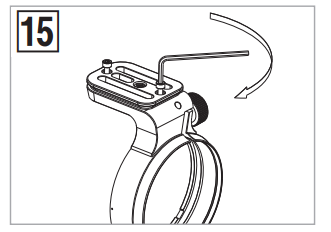
Note
- The A025 tripod mount can be attached to an ARCA-SWISS camera platform.
SAFETY LOCK SCREW
We recommend attaching the lock screws by the camera platform type when you use an ARCA-SWISS-standard compatible camera platform or clamp.
How to use safety lock screws
The safety lock screws ( prevent the lens/camera from falling from the camera platform when a tripod mount is attached to an ARCA-SWISS-standard compatible camera platform or clamp. As shown in the figure, use the hexagonal wrench to tighten the safety lock screws 24 to the two screw holes 23.
Note
- After attaching the safety lock screws. the screw heads protrude from the tripod mount bottom surface to prevent the lens/camera from falling. For this reason, if you are using a camera platform or a clamp other than ARCA- SWISS-standard compatible, you usually do not need to have them attached
PRECAUTIONS WHEN SHOOTING
- An internal focusing (IF) system is employed to achieve the minimum focus distance. Because of this, the shooting range is wider than that of lenses using other focusing systems when shooting at a distance less than infinity.
- Always remove the hood when you use the built-in flash on the camera for flash photography. Otherwise, the hood or lens may darken the perimeter of the image. With close-up photography, the lens blocks the flash, and a dark semicircle may appear at the bottom of the screen, even when the lens hood is not used. For flash photography, we recommend that you use an external flash unit provided by the camera manufacturer.
- Differences in the display systems of cameras may result in the display of values different from the maximum and minimum aperture values in the specifications. This is not an indication of an error.
- Use with mirrorless interchangeable-lens- lens cameras is not guaranteed.
TO ENSURE LONG-TERM SATISFACTION
- Remove dust and soiling on the lens by using a blower or soft brush. Do not touch the lens with your fingers.
- The lens surface of the front element has been coated to prevent water and oily substances from adhering. Since it will repel water, do not use lens cleaners or other substances but only a dry cloth to clean the front element.
- To clean the lens surface of the rear element, lightly wipe it starting from the center with a commercially available lens cleaning paper, a clean cotton cloth, or a microfiber cloth (cleaning cloth for glasses, etc.) soaked in lens cleaner. Do not use a silicone cloth.
- Clean the lens barrel using a silicone cloth. Never use benzene, thinner, or other organic solvents.
- Mildew is a major problem for lenses. Store your lens in a clean, cool, and dry place. When you store the lens in a lens case, store it with a commercially available drying agent and replace the drying agent occasionally.
- Do not touch the lens-camera interface contacts. If dust or stains cause contact problems, signals are not transmitted properly between the lens and camera, and malfunctions may occur.
- If the temperature changes suddenly, moisture may form within the camera and lens and cause malfunctions. To prevent this, seal your equipment in a plastic bag or similar container. After your equipment has adjusted to the ambient temperature, remove it from the bag and use it as usual.
Disposal of Electrical and Electronic Equipment in Private Households. Disposal of used Electrical & Electronic Equipment (Applicable in the European Union and other European countries with separate collection systems)
This symbol indicates that this product shall not be treated as household waste. Instead, it shall be collected separately for the recycling of electrical and electronic equipment. If new products are purchased, this product might be handed over to the distributor or the collection system of waste electrical and electronic equipment eventually. By ensuring this product is disposed of correctly, you will help prevent potential negative consequences for the environment and human health, which could otherwise be caused by inappropriate waste handling of this product or components of this product. If this product is disposed of illegally, it might cause a possibility of penalties. For more detailed information about recycling this product, please contact your local Civic Office, your household waste disposal service, or the shop where you purchased the product.
Precautions for Safe Use of Tamron Lenses
For safe operation be sure to carefully read the “Precautions for Safe Use of Tamron Lenses” and the manual before using the product. After reading them, store them in a place where they can easily be reviewed whenever needed. Caution instructions are divided into the following two categories according to the degree of danger involved.
WARNING
This indicates instructions that if not followed or if performed incorrectly could lead to death or serious injury.
- Do not view the sun or other strong light source directly through the lens or a camera while using this lens. Doing so could cause loss of vision, damage to the lens and the camera, and possibly cause the lens and camera to ignite.
- Do not disassemble, repair, or modify the lens. This could damage the lens or camera.
- Keep the lens out of the reach of small children. There is a risk of injury if the lens is dropped or falls.
CAUTION
This indicates instructions that if not heeded or if performed incorrectly could lead to bodily injury or physical damage
- Do not place the lens in direct sunlight or leave it in an extremely hot place such as inside a car. Doing such could damage the internal parts of the lens or cause a fire.
- Permanently attach the lens cap whenever the lens is not in use.
- When attaching the lens to the camera, ensure that the lens has been properly attached to the camera and firmly locked. If the lens is not attached properly, it could be challenging to remove or it could fall off causing damage or injury.
- Do not use this lens for any application other than photography.
- Do not transport the lens while it is still attached to a tripod.
FAQS About Tamron SP 70-200mm VC G2 lens for Nikon
Image stabilization is there with the Tamron 70-200?
According to CIPA standards, Tamron’s best-in-class VC* image stabilization performance is comparable to 5 stops**.
The Tamron 70-200 G2 is weather sealed, right?
The lens is “moisture-proof and dust-resistant,” according to Tamron.
What is the Tamron 70-200 G2’s sharpest aperture?
f/2.8 to f/8
What VC settings does the Tamron 70-200mm G2 have?
There are three VC modes available: VC Mode 1, VC Mode 2, and VC Mode 3.
What aperture works best with the Nikon 70/200?
f/2.8
Tamron 70 200: Full-frame capable?
For use with full-frame Canon EF-mount DSLRs, this lens was created.
What is the Tamron 70 200 G2’s thread size?
77mm
What is the Nikon 70-200mm lens’s minimum focus distance?
0.5 m/1.64 ft
What about the Tamron 70-200mm?
Tamron merits a rating of Highly Recommended.
What purpose does a 70-200mm lens serve?
You may record the action with the 70-200mm lens without getting in the way and disturbing the scene.
For more manuals by Tamron, Visit Manualsdock
[embeddoc url=”https://manualsdock.com/wp-content/uploads/2023/09/Tamron-SP-70-200mm-VC-G2-lens-for-Nikon-Owner-Manual.pdf” download=”all”]


